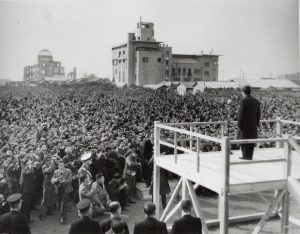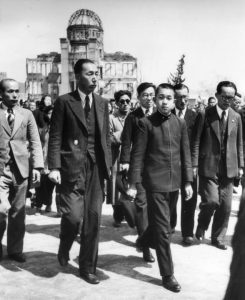Documenting Hiroshima 80 years after A-bombing: On December 7, 1947, Emperor Showa visits area near hypocenter, gathering crowd of 50,000
Feb. 2, 2025
by Kyosuke Mizukawa, Senior Staff Writer
On December 7, 1947, Emperor Showa (also known as Emperor Hirohito) visited Hiroshima City for the first time after the atomic bombing. According to an article published in the Chugoku Shimbun on December 8, “around 50,000 citizens, including war victims” had gathered in Citizens Park in front of the former Hiroshima Gokoku Shrine (in the city’s present-day Naka Ward) near the hypocenter. The Emperor delivered his “remarks” from a “welcoming platform” for distinguished guests.
In the same article, the Emperor was quoted as saying, “I am delighted by the enthusiastic welcome I have received from everyone. I feel satisfied to see firsthand signs of Hiroshima City’s recovery. I cannot help but feel sympathy for the catastrophe Hiroshima City experienced.”
In the Imperial Rescript of the Termination of the War, broadcast by radio on August 15, 1945, the Emperor had said, “The enemy has begun to employ a new and most cruel bomb,” alluding to the tragedies that befell Hiroshima and Nagasaki. In September, the Emperor dispatched Chamberlain Akira Nagazumi to Hiroshima to review the damages in the city. The Emperor had seen a collection of photos that documented the devastation.
In January 1946, the Emperor issued the Humanity Declaration, renouncing his divine status, and in May 1947, a new constitution, replacing the Constitution of Imperial Japan, took effect. Article 1 of the Constitution of Japan declared that, “The Emperor is the symbol of the State and of the unity of the people, deriving his position from the will of the people with whom resides sovereign power.”
Calling for world peace
Emperor Showa’s visit to Hiroshima was part of a tour of regional areas in Japan that had begun in February 1946. The Emperor concluded his speech with the remarks, “Rather than letting this sacrifice go to waste, we must construct a peaceful Japan that will contribute to world peace.”
“When the Emperor finished speaking, a cry of excitement arose from what had been a completely silent audience,” wrote Shinso Hamai, Hiroshima City mayor at the time, in his book Genbaku Shicho (in English, ‘A-bomb mayor’), published in 1967. Later, when Mr. Hamai explained the situation in the city to the Emperor from the roof of City Hall, “The Emperor said only a few words, ‘Houses have been built.’”
On December 8, 1947, the Chugoku Shimbun published a front-page article describing how citizens had welcomed the Emperor under the headline, “Pledging ‘Peaceful Japan’ with Tears.” Overseas media also reported Emperor Showa’s visit to Hiroshima, with the U.S. newspaper The New York Times running an article that implied Emperor Showa had rejected any idea of a new ‘Pearl Harbor attack.’
On December 8, 1941, an Imperial Proclamation of War was issued in which Emperor Showa revealed his intentions. At the end of the war with the United States that Japan had begun, the atomic bomb was dropped on Hiroshima. Keiji Nakazawa is a manga artist who lost his father, older sister, and younger brother shortly after the A-bombing and passed away in 2012 at the age of 73. In his 1994 Hadashi no Gen Jiden (in English, “Autobiography of Barefoot Gen”), he wrote that when he had seen people waving flags in celebration, “I desperately suppressed my anger, trembling.” He was eight years old at the time.
Inviting Japan’s Crown Prince
Following Emperor Showa’s visit, a movement to invite Japan’s Crown Prince (now Emperor Emeritus Akihito) was initiated by representatives of children in Hiroshima. In March 1948, they sent an invitation to the Crown Prince, requesting his attendance at the opening ceremony of the Hiroshima Children’s Culture Hall in the area of Motomachi (in the city’s present-day Naka Ward). They were hoping that his visit would “provide encouragement to the children who had big dreams of rebuilding Japan,” according to the Chugoku Shimbun in an article dated March 28.
The visit to the opening ceremony in May never took place, but the Crown Prince, 15 at the time, ultimately visited Hiroshima on April 5 and 6th, 1949. He visited Peace Tower and the City’s Memorial Monument for the War Victims, in the area near the hypocenter. At a welcome party at the Hiroshima Children’s Culture Hall, the Crown Prince delivered the following remarks, which the evening newspaper Yukan Hiroshima reported in an article on April 7.
“We must move toward peace with a firm resolve so that humanity will never fall into such a tragedy again. To achieve this, you, the people of Hiroshima, must become a powerful force through your own experiences. Please do your best. I, too, am aware of my responsibility and will work hard at my studies and self-improvement.”
(Originally published on February 2, 2025)
On December 7, 1947, Emperor Showa (also known as Emperor Hirohito) visited Hiroshima City for the first time after the atomic bombing. According to an article published in the Chugoku Shimbun on December 8, “around 50,000 citizens, including war victims” had gathered in Citizens Park in front of the former Hiroshima Gokoku Shrine (in the city’s present-day Naka Ward) near the hypocenter. The Emperor delivered his “remarks” from a “welcoming platform” for distinguished guests.
In the same article, the Emperor was quoted as saying, “I am delighted by the enthusiastic welcome I have received from everyone. I feel satisfied to see firsthand signs of Hiroshima City’s recovery. I cannot help but feel sympathy for the catastrophe Hiroshima City experienced.”
In the Imperial Rescript of the Termination of the War, broadcast by radio on August 15, 1945, the Emperor had said, “The enemy has begun to employ a new and most cruel bomb,” alluding to the tragedies that befell Hiroshima and Nagasaki. In September, the Emperor dispatched Chamberlain Akira Nagazumi to Hiroshima to review the damages in the city. The Emperor had seen a collection of photos that documented the devastation.
In January 1946, the Emperor issued the Humanity Declaration, renouncing his divine status, and in May 1947, a new constitution, replacing the Constitution of Imperial Japan, took effect. Article 1 of the Constitution of Japan declared that, “The Emperor is the symbol of the State and of the unity of the people, deriving his position from the will of the people with whom resides sovereign power.”
Calling for world peace
Emperor Showa’s visit to Hiroshima was part of a tour of regional areas in Japan that had begun in February 1946. The Emperor concluded his speech with the remarks, “Rather than letting this sacrifice go to waste, we must construct a peaceful Japan that will contribute to world peace.”
“When the Emperor finished speaking, a cry of excitement arose from what had been a completely silent audience,” wrote Shinso Hamai, Hiroshima City mayor at the time, in his book Genbaku Shicho (in English, ‘A-bomb mayor’), published in 1967. Later, when Mr. Hamai explained the situation in the city to the Emperor from the roof of City Hall, “The Emperor said only a few words, ‘Houses have been built.’”
On December 8, 1947, the Chugoku Shimbun published a front-page article describing how citizens had welcomed the Emperor under the headline, “Pledging ‘Peaceful Japan’ with Tears.” Overseas media also reported Emperor Showa’s visit to Hiroshima, with the U.S. newspaper The New York Times running an article that implied Emperor Showa had rejected any idea of a new ‘Pearl Harbor attack.’
On December 8, 1941, an Imperial Proclamation of War was issued in which Emperor Showa revealed his intentions. At the end of the war with the United States that Japan had begun, the atomic bomb was dropped on Hiroshima. Keiji Nakazawa is a manga artist who lost his father, older sister, and younger brother shortly after the A-bombing and passed away in 2012 at the age of 73. In his 1994 Hadashi no Gen Jiden (in English, “Autobiography of Barefoot Gen”), he wrote that when he had seen people waving flags in celebration, “I desperately suppressed my anger, trembling.” He was eight years old at the time.
Inviting Japan’s Crown Prince
Following Emperor Showa’s visit, a movement to invite Japan’s Crown Prince (now Emperor Emeritus Akihito) was initiated by representatives of children in Hiroshima. In March 1948, they sent an invitation to the Crown Prince, requesting his attendance at the opening ceremony of the Hiroshima Children’s Culture Hall in the area of Motomachi (in the city’s present-day Naka Ward). They were hoping that his visit would “provide encouragement to the children who had big dreams of rebuilding Japan,” according to the Chugoku Shimbun in an article dated March 28.
The visit to the opening ceremony in May never took place, but the Crown Prince, 15 at the time, ultimately visited Hiroshima on April 5 and 6th, 1949. He visited Peace Tower and the City’s Memorial Monument for the War Victims, in the area near the hypocenter. At a welcome party at the Hiroshima Children’s Culture Hall, the Crown Prince delivered the following remarks, which the evening newspaper Yukan Hiroshima reported in an article on April 7.
“We must move toward peace with a firm resolve so that humanity will never fall into such a tragedy again. To achieve this, you, the people of Hiroshima, must become a powerful force through your own experiences. Please do your best. I, too, am aware of my responsibility and will work hard at my studies and self-improvement.”
(Originally published on February 2, 2025)









